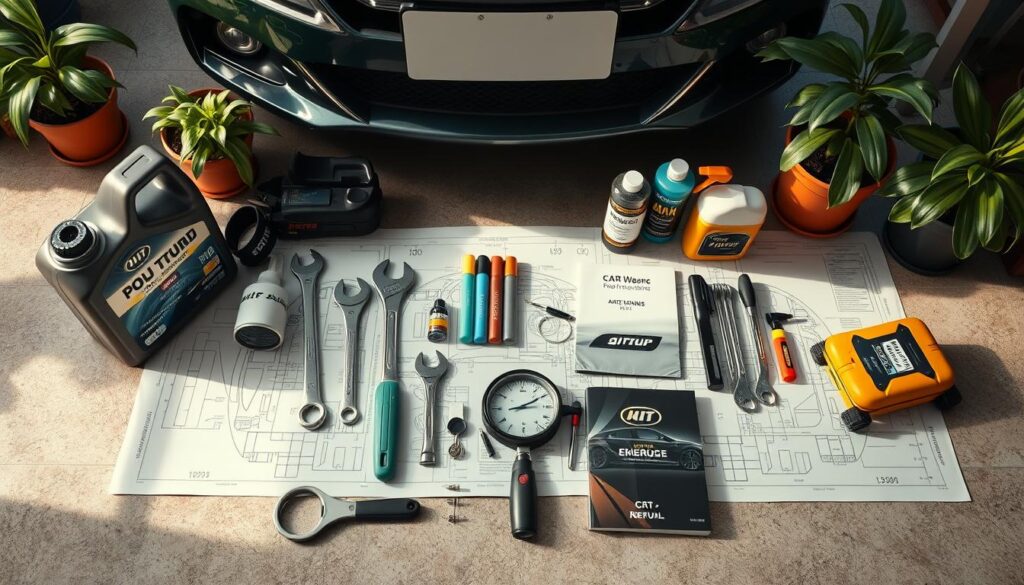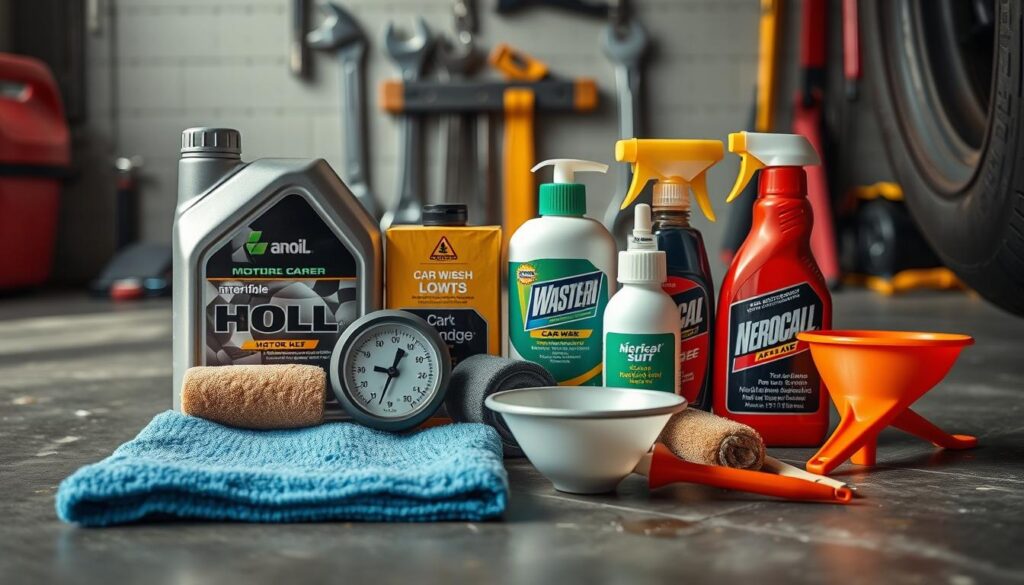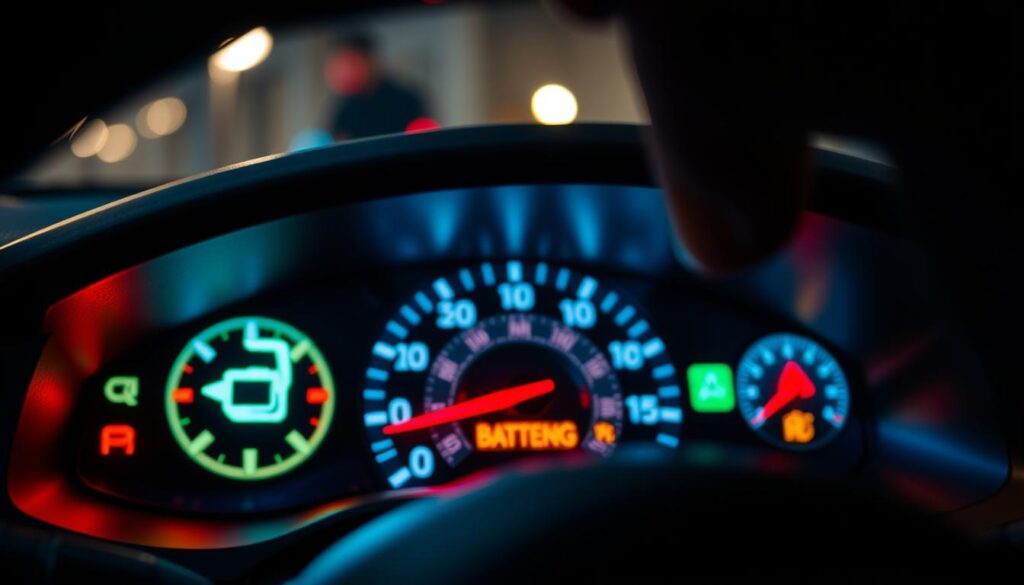
Do you know how many hidden costs and safety risks come from ignoring basic car care? Many drivers don’t realize how important regular maintenance is until it’s too late. In this guide, you’ll find tips to keep your car running well, last longer, and save money on repairs.
By following the car maintenance tips in your owner’s manual, you’ll learn to keep your vehicle in top shape. This approach will help you avoid costly problems and ensure your car runs smoothly.

Key Takeaways
- Understanding vehicle systems is crucial for effective car maintenance.
- Routine checks, like oil changes every 5,000 to 7,500 miles, can prevent major issues.
- Regularly rotating tires every 5,000 miles increases tire longevity and performance.
- Monitoring brake pads and rotors is essential, as they typically last between 25,000 and 65,000 miles.
- Maintaining fluid levels, including brake and transmission fluids, every 30,000 to 60,000 miles ensures optimal vehicle function.
- Keeping a detailed service history assists in identifying patterns in your vehicle’s performance.
- Driving habits can significantly affect your vehicle’s health; gentle driving helps reduce wear and tear.
Understanding Your Vehicle: The Importance of the Owner’s Manual
Your owner’s manual is a key resource for car owners. It gives you important details about your vehicle. This includes how to maintain it, how it works, and safety tips. Knowing this information helps your car last longer.
What to Look for in Your Owner’s Manual
When you look at your owner’s manual, focus on these parts:
- Maintenance Schedule: It tells you when to change oil, replace filters, and more to keep your car running well.
- Fluid Levels: It shows how to check and add engine oil and coolant.
- Safety Information: It has warnings and tips to help you drive safely and avoid problems.
- Warranty Coverage: It explains what’s covered, for how long, and what might void your warranty.
- Gas Requirements: It suggests the best fuel and gives tips for better gas mileage.
Creating an Automotive Maintenance Checklist
Make a maintenance checklist using your owner’s manual. Regular checks on oil, tire pressure, and brakes can spot problems early. This can save you from expensive repairs later.
Here’s an example of a maintenance checklist based on your owner’s manual:
| Maintenance Task | Frequency | Last Completed |
|---|---|---|
| Oil Change | Every 5,000 miles | [Date] |
| Tire Rotation | Every 6,000 miles | [Date] |
| Brake Inspection | Every 10,000 miles | [Date] |
| Fluid Check | Monthly | [Date] |
| General Cleaning | Every Month | [Date] |
Key Routine Car Services for Optimal Performance
Keeping your car in top shape is crucial for its performance and life span. Using the 30/60/90 rule helps schedule important services. This rule outlines tasks for 30,000, 60,000, and 90,000 miles, ensuring your car gets the right care on time.
Understanding the 30/60/90 Rule for Car Maintenance
The 30/60/90 rule is a guide for car owners to plan maintenance. For example:
- At 30,000 miles: Change the oil, check fluids, inspect brakes, and clean air filters.
- At 60,000 miles: Do deeper checks like battery tests, tire checks, and fluid replacements.
- At 90,000 miles: Spark plugs usually need to be replaced.
Essential Routine Services: Oil Changes and Fluid Checks
Oil changes are key to keeping your car running well. Most cars need an oil change every 5,000 to 7,500 miles. But, always check your car’s manual for the exact time. It’s also important to check fluids regularly.
Checking antifreeze, brake fluid, and transmission fluid helps avoid overheating. Overheating can damage your engine badly. Make sure to check these fluids monthly and before long trips.
Following the 30/60/90 rule and focusing on oil changes and fluid checks will keep your car running smoothly. It also helps extend your car’s life.
| Mileage | Recommended Services |
|---|---|
| 30,000 miles | Oil change, brake inspection, fluid checks, air filter inspection |
| 60,000 miles | Batteries and tire checks, transmission fluid replacement, timing belt inspection |
| 90,000 miles | Spark plug replacement, engine inspection |
Best Practices to Maintain Your Car for Longevity
Keeping your car in good shape is key to its long life. By following some simple steps, you can make your car last longer. This includes checking tire pressure, taking care of your windshield, and cleaning and waxing your car.
Regular Checks on Tire Pressure and Rotation
Checking your tire pressure is a must. Do it at least once a month to prevent blowouts and save on gas. Low tire pressure makes your engine work harder.
Look for the recommended pressure on a sticker inside your driver’s side door. Also, rotate your tires every 5,000 miles. This keeps them wearing evenly and makes your car safer and more efficient.
Importance of Maintaining Windshield Wipers
Having a clear view is crucial for safe driving. So, keeping your windshield wipers in good shape is important. Replace them every six months to avoid scratches and poor visibility in bad weather.
How Cleaning and Waxing Protect Your Vehicle
Cleaning and waxing do more than make your car look good. Washing it regularly keeps it safe from damage. It stops dirt and harmful substances from causing harm.
Waxing your car at least twice a year adds a protective layer. It shields your car from UV rays, road salt, and other debris. This keeps your car looking new and increases its value.

Common Warning Signs to Watch For
Knowing the warning signs is key to keeping your car in top shape. Spotting dash warning lights and tuning into your car’s sounds can save you money and keep you safe. It’s important to understand what these signs mean to avoid costly repairs.
Decoding Dash Warning Lights
Modern cars have many dash warning lights. A check engine light might mean a loose gas cap or a big engine problem. The low oil light is a must-watch, as it prevents engine damage. Other lights warn about tire pressure, which drops with temperature changes.
Fixing these issues quickly is vital for your car’s health.
Listening to Your Car: Key Noises and Smells to Note
Pay attention to your car’s sounds and smells too. Grinding or squealing noises can mean worn brake pads. Clunking or hissing sounds might point to mechanical problems. Don’t ignore smells like burning rubber or rotten eggs, as they can signal leaks or exhaust issues.

Conclusion
To keep your car in top shape, you need to know what to do and actually do it. Start by making a solid vehicle upkeep plan. This includes following your owner’s manual and getting regular services.
Regular checks can spot safety issues early. This makes your drives safer and keeps your car running well.
Using expert maintenance tips can make your car last longer and use less fuel. A well-cared-for car also pollutes less, helping the environment. Plus, it keeps its value higher, making regular checks worth it.
Things like oil changes and tire rotations prevent big repair bills later. By doing these things regularly, your car stays safe and reliable for a long time.
FAQ
How often should I perform routine car maintenance?
Check your owner’s manual for a maintenance schedule. It’s good to check oil and fluids monthly. Oil changes are needed every 5,000 to 7,500 miles. Also, follow the 30/60/90 mile service intervals.
What should I include in my automotive maintenance checklist?
Your checklist should cover oil, tire pressure, brakes, and fluids. Don’t forget tire rotation, windshield wiper replacement, and regular cleanings. These steps help your car last longer.
How does the 30/60/90 rule affect my car maintenance schedule?
The 30/60/90 rule helps keep your car in top shape. At 30,000 miles, change oil and filters, and check brakes and fluids. At 60,000 miles, check the battery and transmission fluid. At 90,000 miles, spark plugs might need to be replaced.
Why is it important to maintain tire pressure?
Keeping tire pressure right is key for safety and fuel savings. Check it monthly. This prevents blowouts and improves handling, making your tires last longer and your car run better.
What are the key warning signs of potential issues in my car?
Watch for dash lights, unusual noises, and strange smells like burning rubber. Fixing these problems early can save you money and keep you safe.
How does cleaning and waxing affect my vehicle?
Cleaning removes harmful substances that can cause rust. Waxing at least twice a year protects against environmental damage. These steps keep your car looking good and running well.







